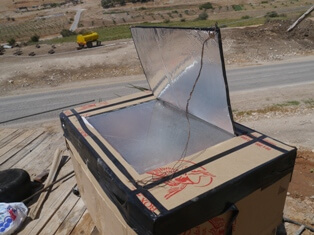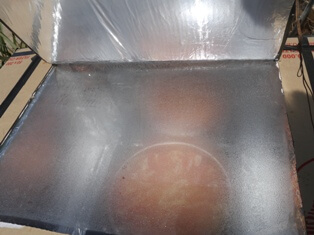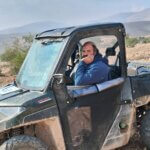Cooking with Solar power
 In the intense heat of the Jordan Valley, where Palestinians have been stripped of their natural resources, and most families are dependent on expensive gas for cooking, we are looking at ways we can use everyday materials to harness the energy of the sun.
In the intense heat of the Jordan Valley, where Palestinians have been stripped of their natural resources, and most families are dependent on expensive gas for cooking, we are looking at ways we can use everyday materials to harness the energy of the sun.
Our latest innovation is the solar oven, made from just cardboard boxes, tin foil and a sheet of glass.
We interviewed one of our new volunteers to find out how it works.
How did you make the oven?
“We used two cardboard boxes, one is bigger than the other and we put the smaller one inside the big and filled the gap between them with papers to insulate. We lined the small box with kitchen foil. Then we made a cover to it, also using cardboard box and a glass sheet, so it would let the sun through but keep the heat inside the box. On the cover we have also the kitchen foil, so according to the sun’s position, we can change the angle of the cover to direct all the sunshine inside the box. We put a black sheet at the bottom of the box.”
What can you cook with it?
“We cook mostly vegetables, sort of slow-roasting and steaming at the same time. First time we just cut tomatoes in half, put them on a tray with some chopped onion, seasoned it with salt, zatar, pepper, olive oil and in 5-6 hours we had a very tasty dinner. The best one was with courgettes, cut in half, scoop the inside out, stuff it with mixed vegetables (tomato, avocado, onion, the inside of the courgette, salt, zatar, pepper).”
Where do you put the food?
“We put the food on a tray or in a pot. It works just as an oven, we put the pot/ tray inside the box, close it and direct the sun inside it. You have to check it in every hour to turn it towards the sun, but not to open the box as all the heat would escape. The tray becomes so hot, when the food is cooked it’s quite hard to take it out, we have to use something to hold it! It’s really amazing.”
Why doesn’t the cardboard box burn?
 “When you want to burn something with using the sun, you have to use magnifying glass to collect the sun into one tiny spot which is so hot that can start a fire, but on the oven it’s just a simple glass-sheet that would let the sun through. The entire cardboard box is lined with kitchen foil, so the sun beams are reflected onto the tray and black sheet in the middle of the box.”
“When you want to burn something with using the sun, you have to use magnifying glass to collect the sun into one tiny spot which is so hot that can start a fire, but on the oven it’s just a simple glass-sheet that would let the sun through. The entire cardboard box is lined with kitchen foil, so the sun beams are reflected onto the tray and black sheet in the middle of the box.”
Do the volunteers use it for cooking all the time?
“You can use it as much as you want. Usually we put the food in around 9am in the morning, and take it out later in the afternoon. The morning sun is stronger, so even if the food is ready by 2 o’clock it’s not worth to put another one in because it wouldn’t be cooked during the afternoon.”
Is this an idea that you’re hoping to share with local communities?
“There’s an idea to make a workshop in the communities and show them how to make it maybe linked with the bio gas reactor (anaerobic digester). It’s very easy, simple and almost free, even children can make it.
“Using solar oven is a sustainable way of cooking as you basically use scrap materials, such as cardboard boxes and glass sheet, and the free energy from the sun. The Jordan Valley’s climate is perfect for this as there are barely any overcast days and it’s getting really hot here during the summer.
“The natural environment in the Jordan Valley, and throughout Palestine, is being destroyed by over extraction of water, industrial scale farming, relocation of environmentally destructive and polluting industries into the settlements in the West Bank, destruction of ancient olive groves, and mass planting of non-indigenous tress such as pines.
“Challenging this destruction of our world is part of challenging the right of the occupation to control the lives of Palestinians.
“Finding ways for people to sustain themselves with very cheap or free resources gives them the means to stay in their homes and their communities. It is all part of our belief that: ‘To exist is to resist’.”






